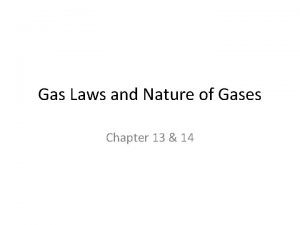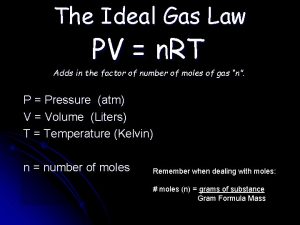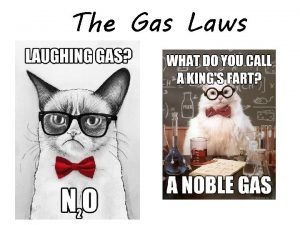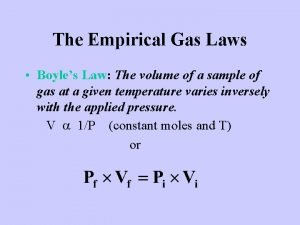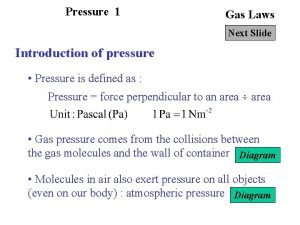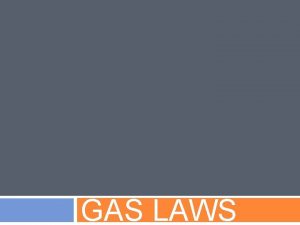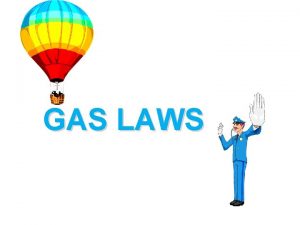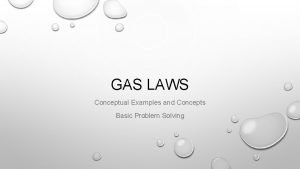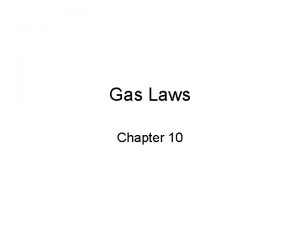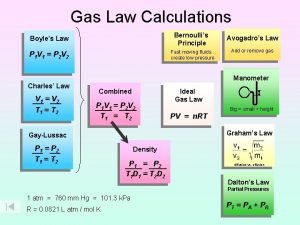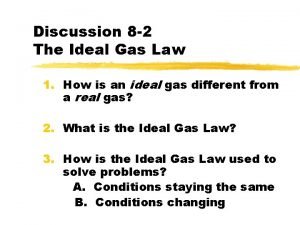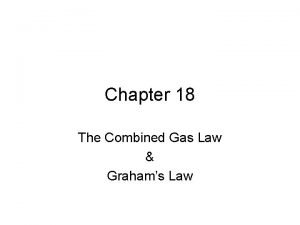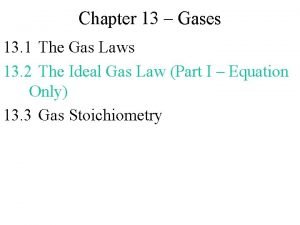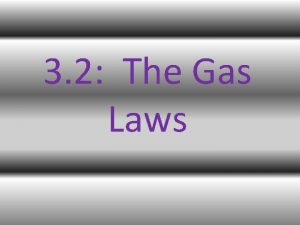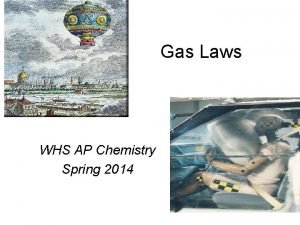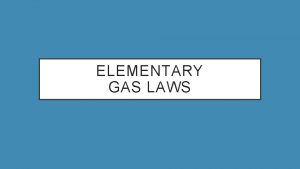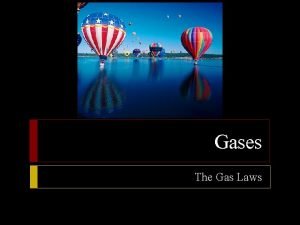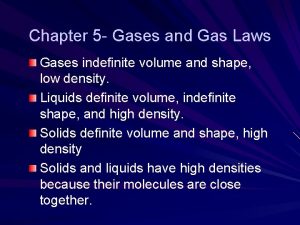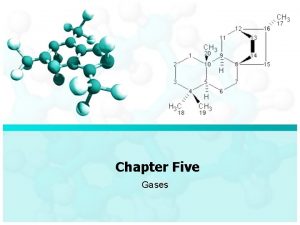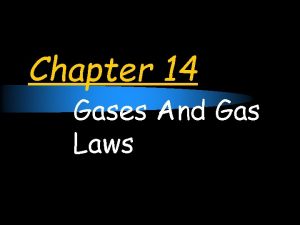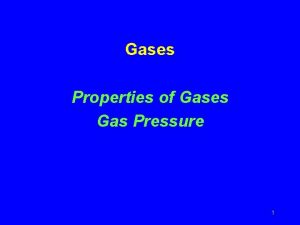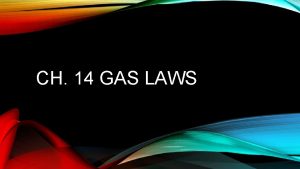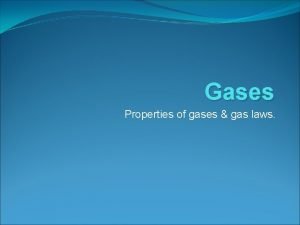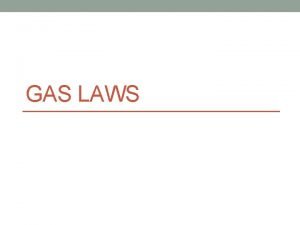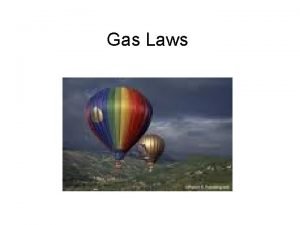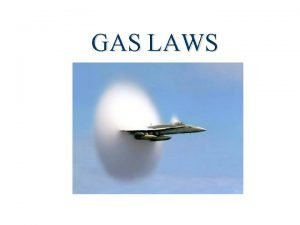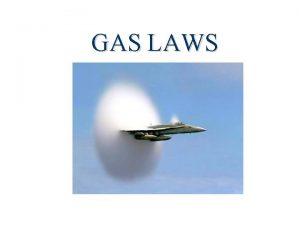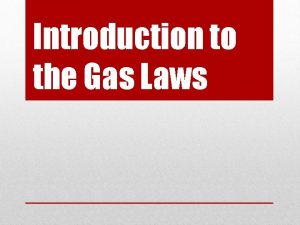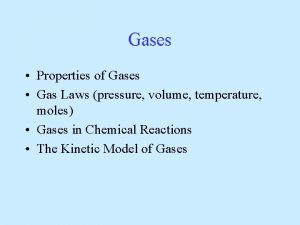Chapter Five Gases Chapter Five Gases Gas Laws

















- Slides: 17

Chapter Five Gases

Chapter Five / Gases Gas Laws The Temperature – Volume Relationships Charle’s and Gay-Lussac’s Law • Charle’s and Gay-Lussac’s law study the relationship between the temperature and volume of gas. • Charle’s and Gay-Lussac’s law stated that the volume of a fixed amount of gas at a constant pressure is directly proportional to the absolute temperature of the gas.

Chapter Five / Gases Gas Laws- Charle’s Law TαV Charle’s Law T in Kelvin

Chapter Five / Gases Gas Laws- Charle’s Law Example: A sample of carbon monoxide gas occupies 3. 20 L at 125 °C. At what temperature will the gas occupy a volume of 1. 54 L if the pressure remains constant? T 2 X 3. 2 = 398 X 1. 54 T 2 = 612. 92/3. 2 = 191. 5 K

Chapter Five / Gases Gas Laws The Volume – Amount Relationships Avogadro’s Law • Avogadro’s law study the relationship between the volume and number of mole of gas. • Avogadro’s law stated that at constant pressure and temperature, the volume is directly proportional to the number of moles of the gas

Chapter Five / Gases Gas Laws- Avogadro’s Law

Chapter Five / Gases Gas Laws- Avogadro’s Law nαV Avogadro’s Law

Chapter Five / Gases Summery of Gas Laws P 1 V 1 = P 2 V 2 Boyle’s Law Constant T and n Charle’s Law Constant P and n Avogadro’s Law Constant P and T

Chapter Five / Gases Ideal Gas Equation We know that PV=n. RT Ideal Gas Equation R Gas constant

Chapter Five / Gases Ideal Gas Equation • Ideal gas is a hypothetical gas whose pressure-volume-temperature behavior can be completely accounted for by the ideal gas equation. • STP : standard Temperature and pressure • Standard Temperature = 0°C = 273. 15 K • Standard Pressure = 1 atm. • At STP 1 mole of an ideal gas occupies 22. 414 L. • R (gas constant ) = 0. 082057 L. atm / K. mol

Chapter Five / Gases Ideal Gas Equation Example 1: Calculate the pressure (in atm) exerted by 1. 82 moles of the sulphur hexaflouride in a steel vessel of volume 5. 43 L at 69. 5 °C. ? PV =n. RT P = n. RT/V = 1. 82 x 0. 082 x (69. 5 +273)/5. 43 =9. 41 atm.

Chapter Five / Gases Ideal Gas Equation Example 2: Calculate the volume (in liters) occupied by 7. 40 g of NH 3 at STP condition. ? PV=n. RT V = n. RT/P n = mass/molar mass n = 7. 40 / 17 = 0. 435 mol V= 0. 435 X 0. 082 X 273 / 1 = 9. 74 L

Chapter Five / Gases Ideal Gas Equation • We can use the ideal gas low if we know three out of four variable namely: P, T, V, n. we can calculate one unknown if we know the other three from the equation of ideal gas. • However, sometime we have to deal with two conditions, this mean we have two P , two V, two T, and two n. thus we need to apply some modification into the equation of ideal gas that take into account the initial and final conditions. PV = n. RT Normally n 1=n 2 And the law become

Chapter Five / Gases Ideal Gas Equation Example 1: A small bubble rises from the bottom of a lake, where the temperature and pressure are 8 °C and 6. 4 atm, to the water surface, where the temperature 25 °C and the pressure is 1 atm. Calculate the final volume (in m. L) of the bubble if its initial volume was 2. 1 m. L. Initial condition Final condition P 1 6. 4 atm P 2 1 atm T 1 8 °C T 2 25 °C V 1 2. 1 ml V 2 ? We assume that amount of air in the bubble remains constant (n 1 = n 2)

Chapter Five / Gases Ideal Gas Equation Example 1: A small bubble rises from the bottom of a lake, where the temperature and pressure are 8 °C and 6. 4 atm, to the water surface, where the temperature 25 °C and the pressure is 1 atm. Calculate the final volume (in m. L) of the bubble if its initial volume was 2. 1 m. L? P 1 V 1 T 2 = P 2 V 2 T 1 V 2 = 14. 25 m. L

Chapter Five / Gases Ideal Gas Equation Example 2: An inflated helium balloon with a volume of 0. 55 L at sea level (1 atm) is allowed to rise to a high of 6. 5 km. where the pressure is about 0. 40 atm. Assuming that the temperature remains constant. What is the final volume of the balloon? We assume that n 1 = n 2 and T 1 = T 2 P 1 V 1 = P 2 V 2 1 x 0. 55 = 0. 4 x V 2 = 0. 55 / 0. 4 = 1. 4 L

 Charles' law worksheet with answers
Charles' law worksheet with answers Useless laws weaken the necessary laws
Useless laws weaken the necessary laws Gas laws crash course
Gas laws crash course Constant direct indirect relationship
Constant direct indirect relationship Gas laws
Gas laws Ideal gas law
Ideal gas law Bourdon gauge gas law
Bourdon gauge gas law Different gas laws
Different gas laws Avogadro's law
Avogadro's law Gas laws conceptual questions
Gas laws conceptual questions What is the formula for boyle's law
What is the formula for boyle's law A gas occupies 473 cm3 at 36°c. find its volume at 94°c
A gas occupies 473 cm3 at 36°c. find its volume at 94°c Different gas laws
Different gas laws Combined gas law worksheet
Combined gas law worksheet Chapter 13 gases
Chapter 13 gases Boyle's law graph
Boyle's law graph Charles law formula
Charles law formula Ap chemistry gas laws
Ap chemistry gas laws
